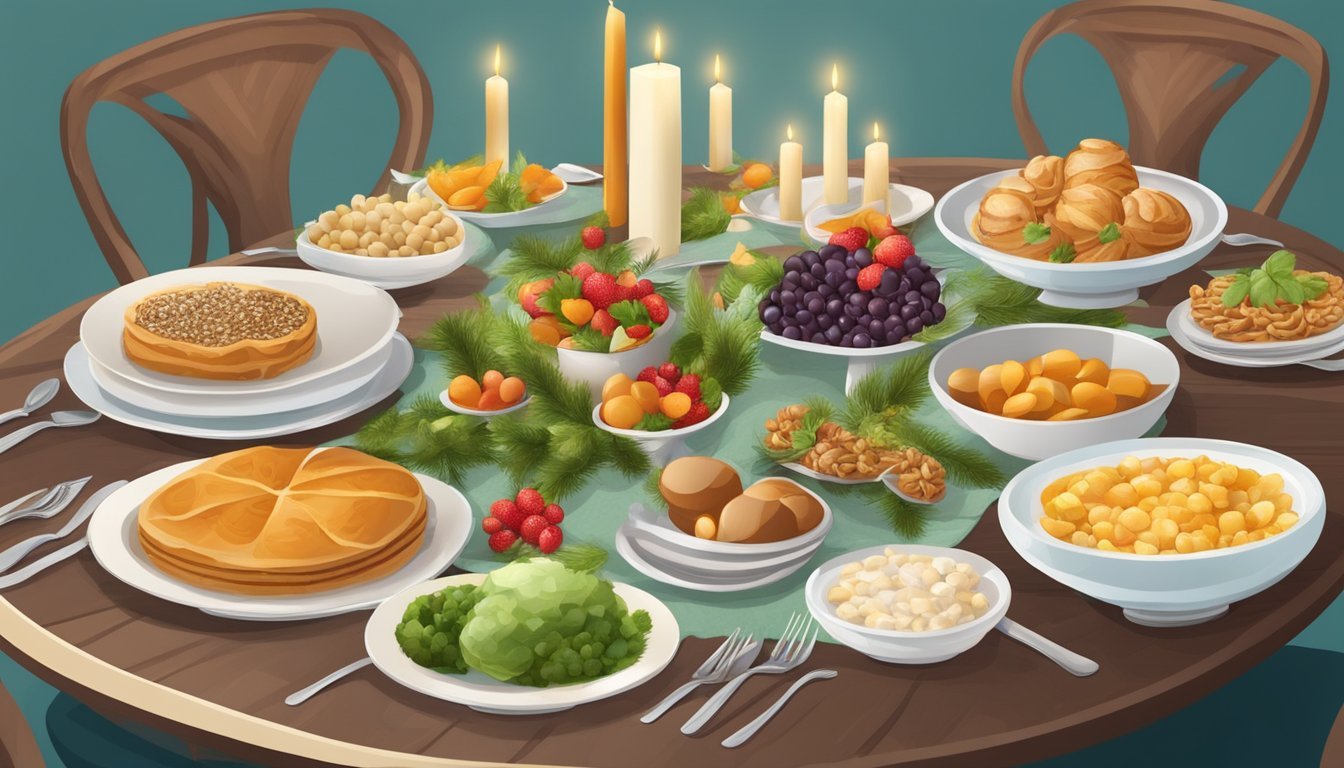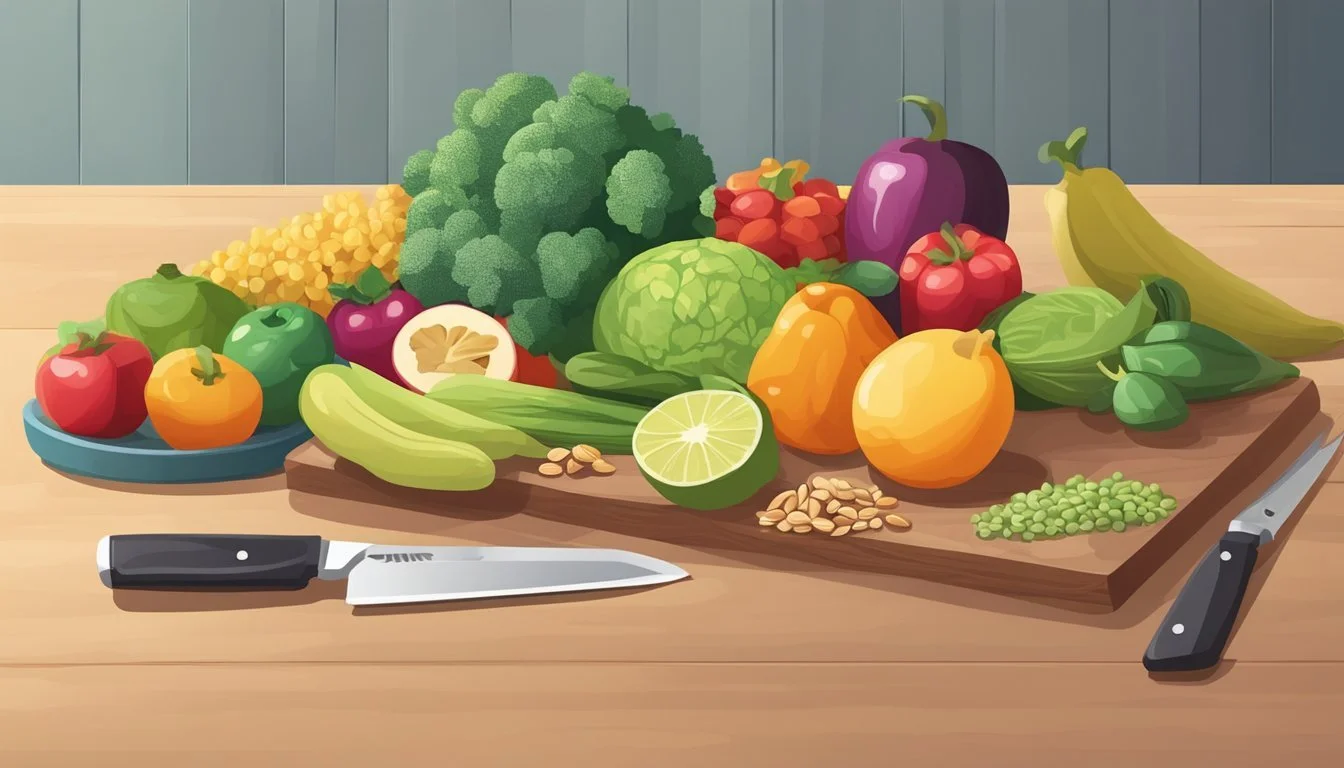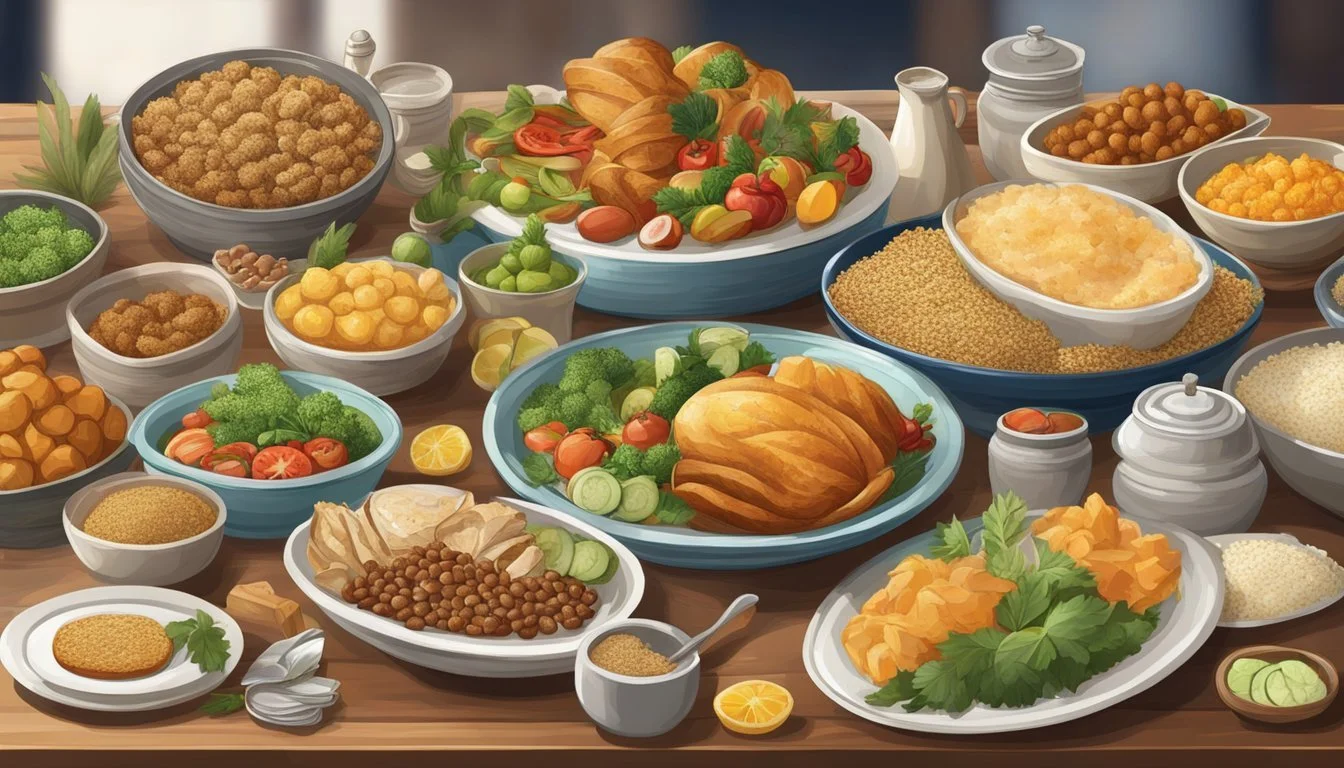Celebrating Holidays and Special Occasions on a Grain-Free Diet
Enjoyment Without Compromise
Celebrating holidays and special occasions often centers around food, with many traditional dishes anchored in grains. For individuals following a grain-free diet due to health conditions like celiac disease, non-celiac gluten sensitivity, or autoimmune diseases, navigating these festivities can be challenging. This approach to eating eliminates grains to reduce inflammation and support overall health, leaving many to wonder how they can partake in festive meals without compromising their dietary restrictions.
Transitioning to a grain-free diet does not mean sacrificing enjoyment during celebrations. A plethora of grain-free alternatives now exist that can help maintain the joy and communal spirit of holiday feasting. By focusing on whole, unprocessed foods and creative substitutions, those on a grain-free diet can relish in a wide array of recipes specifically designed to align with their health needs while still evoking the essence of traditional holiday flavors.
Innovation in the kitchen has led to the reinvention of classic holiday dishes into grain-free masterpieces. Whether it's through using nut flours for baking or embracing a bounty of vegetables and proteins, individuals can craft a celebratory table that caters to their dietary preferences. Recipes and cookbooks dedicated to grain-free living offer a wealth of ideas for transforming holiday fare into meals that are both delicious and compliant with a grain-free lifestyle.
Celebrating holidays and special occasions while following a grain-free diet can be a delightful and fulfilling experience. With a little creativity and planning, you can indulge in festive delights while staying true to your dietary goals and supporting your well-being.
Exploring the rich tapestry of grain-free international cuisine is a wonderful way to infuse special occasions with diverse flavors and cultural traditions. From flavorful curries to tantalizing stir-fries, there are endless possibilities to create memorable and grain-free feasts that honor global culinary heritage.
Building a well-stocked grain-free kitchen pantry filled with versatile grain-free flour alternatives empowers you to craft delectable treats and dishes for any celebration. Whether it's almond flour for baking or coconut flour for savory creations, having these essentials at hand ensures that you can whip up delightful grain-free delights with ease.
For pet owners, ensuring that your furry friends can also partake in the festivities is important. With a variety of grain-free pet products and recipes available, you can include your pets in the joy of special occasions while prioritizing their health and well-being.
Understanding the role of grains in human health history and the potential impact on grain-free digestive disorders can deepen your appreciation for celebrating holidays in a way that aligns with your dietary choices and supports your overall wellness.
Navigating grain-free hidden grains labels during holiday meal planning becomes a seamless task when armed with knowledge and support, allowing you to savor the occasion without compromising your grain-free commitment. By embracing the richness of grain-free living during special occasions, you can create cherished memories and savor the joy of festive gatherings while honoring your dietary preferences and well-being.
Understanding the Basics of a Grain-Free Diet
Adopting a grain-free diet involves the exclusion of all grains and often seeks to reduce inflammation and assist in managing health conditions such as diabetes. This approach concentrates on whole foods while shunning processed options.
What Is a Grain-Free Diet?
A grain-free diet entails the removal of all grains, including wheat, corn, rice, barley, rye, and oats. Unlike a gluten-free diet that primarily eliminates gluten-containing grains such as wheat, barley, and rye, a grain-free diet also excludes gluten-free grains like rice and corn. It extends to nix processed foods derived from grains, including bread, pasta, cereal, and snack items like crackers. Grains such as amaranth and buckwheat are pseudocereals and are often permitted in moderation.
Benefits and Challenges
Individuals may experience benefits such as weight loss and reduced inflammatory responses, substantial in managing conditions like diabetes. By cutting out grains, proponents believe they can better avoid processed foods, which often contain added sugar and unhealthy fats. The challenges lie in ensuring a balanced diet rich in all essential nutrients while avoiding dairy and sugar, which can sometimes be over-consumed as a substitute for grains.
Common Misconceptions
One misconception is that grain-free and gluten-free mean the same thing; they do not, as gluten-free diets allow gluten-free grains. Also, some may believe a grain-free diet guarantees weight loss, but results vary and depend on overall diet and lifestyle choices. Misunderstanding can also arise regarding the nutritional adequacy of grain-free diets; careful planning is necessary to maintain a balanced intake of nutrients typically rich in grains.
Grain-Free Ingredients to Celebrate With
Grain-free diets can be just as festive and flavorful as traditional ones. By focusing on proteins, vegetables, fruits, and grain-free flours, one can craft a delicious and healthy celebration menu.
Choosing Healthy Proteins
Proteins are the building block of any nutritious diet. For a grain-free lifestyle, meat such as turkey, chicken, and beef provide essential amino acids. Fish offers a lighter alternative, packed with omega-3 fatty acids. Celebratory dishes can include a roasted leg of lamb or baked salmon. Eggs are versatile for various dishes, offering protein along with critical minerals like magnesium.
Meats: Turkey, Chicken, Beef, Lamb
Fish: Salmon, Tuna, Cod
Eggs: Free-range, Organic
Embracing Vegetables and Fruits
Vegetables and fruits not only provide essential vitamins and fiber but also add color and texture to grain-free meals. One should incorporate a variety of vegetables like cauliflower for a hearty substitute to grains, zucchini spiralized into noodles, and potatoes for a comforting presence. Fruits can be both a sweet treat and a rich source of nutrients, suitable for desserts or as part of a savory dish.
Vegetables: Cauliflower, Zucchini, Potatoes
Fruits: Apples, Berries, Citrus
Discovering Grain-Free Flours
Grain-free flours such as almond flour and coconut flour are excellent for baking holiday treats. They offer a high protein and fiber content and are a staple for anyone looking to indulge in holiday desserts without grains. These flours work well for cookies, cakes, and bread alternatives, with a simple swap for traditional wheat flour.
Almond Flour: High in protein, good for baking
Coconut Flour: High in fiber, suitable for desserts
Incorporating Nuts and Seeds
Nuts and seeds are not just snacks; they are powerhouses of nutrients like magnesium and fiber. They can be used whole, ground into flour, or turned into dairy-free milk. Include nuts like almonds and walnuts in desserts or as a crust for proteins, and use seeds such as chia and flaxseed to add texture and nutrition to grain-free dishes.
Nuts: Almonds, Walnuts, Pecans
Seeds: Chia, Flaxseed, Pumpkin Seeds
By selecting a variety of proteins, vegetables, fruits, and specialty flours, and by creatively incorporating nuts and seeds, anyone can create a festive, grain-free celebration that is both satisfying and aligned with their dietary preferences.
Delectable Grain-Free Recipes for Special Occasions
Adhering to a grain-free diet during holidays and special events is feasible and can still be indulgent with the right recipes. These carefully selected grain-free options include classic treats, innovative desserts, and satisfying savories to make celebrations both memorable and delicious.
Creating Grain-Free Versions of Classic Treats
Grain-free baking flourishes with the use of alternative flours, such as almond and coconut flour, offering healthier substitutes without compromising taste. Grain-Free Carrot Cake, for example, can be made using a blend of these flours, combined with fresh grated carrots, cinnamon, and a sweet, creamy coconut oil-based frosting. For those who desire the warm spices and sweetness of classic desserts, Spiced Molasses Cookies provide a rich, chewy experience with the use of grain-free flours and unrefined sweeteners like maple syrup.
Inventive Dessert Options
Alternatives to traditional grain-based desserts can offer a refreshing twist to the dessert table. A fresh and sweet Apple Crisp makes use of thinly sliced apples, a sprinkle of cinnamon, and a crunchy, grain-free topping made with nuts and seeds. This dessert provides a satisfying end to a meal without any of the grains. Another creative option is a Cranberry Coconut Tart, combining tart cranberries with a sweet crisp crust, delivering a dessert that is as visually appealing as it is palatable.
Savory Sides and Main Courses
Moving beyond sweets, a grain-free diet can transform side dishes and main courses into the stars of the meal. A side like Loaded Broccoli Salad is both crunchy and flavorful, incorporating a tangy dressing and diverse textures from raw broccoli, onions, and a selection of seeds. For mains, a grain-free Chicken Pizza can be crafted using a cauliflower-based crust, topped with marinara sauce, shredded chicken, and a generous sprinkle of vegetables and herbs.
By focusing on natural, grain-free ingredients and employing creative cooking techniques, every special occasion can be both a delicious and health-conscious celebration.
Grain-Free Diet Adaptations for Various Health Protocols
Adapting holiday meals to fit various health protocols requires careful selection of ingredients and cooking methods. The following subsections explore how to tailor grain-free celebrations for different dietary needs while ensuring delicious and festive options.
Paleo and Keto-Friendly Celebrations
Paleo and keto diets share a focus on excluding grains, legumes, and processed sugars, which simplifies the creation of holiday menus that suit both. Celebrants can emphasize high-fat, low-carb ingredients for keto compliance, while paleo celebrators will prioritize whole, unprocessed foods. A festive paleo and keto-friendly menu may include:
A main course of roasted turkey or ham that avoids sugar-laden glazes.
Sides such as roasted Brussels sprouts with bacon, cauliflower mash topped with chives, and spinach salad with a vinaigrette dressing.
For dessert, offerings like almond flour-based pumpkin pie or coconut cream-based custards ensure sweetness without grains.
Vegan and Vegetarian Adjustments
Vegan and vegetarian grain-free celebrants often replace traditional proteins with legume-free plant-based options like tofu, tempeh, and nut-based "cheeses." These adjustments allow for the inclusion of festive favorites while ensuring they're vegan and dairy-free. Suggested dishes include:
Stuffed bell peppers (What wine goes well with stuffed bell peppers?) with a mixture of quinoa and mixed vegetables as a hearty entree.
Dairy-free, nut-based cheese platters accompanied by gluten-free, grain-free seed crackers.
Vegan and vegetarian dishes (What wine goes well with vegetarian dishes?) often require careful attention to detail, as some plant-based substitutes can introduce grains inadvertently.
Managing Food Allergies and Sensitivities
Those with food allergies, celiac disease, or non-celiac gluten sensitivity require allergy-friendly and AIP compliant (Autoimmune Protocol) meal options. Creating a holiday menu suitable for these individuals can include:
Gluten-free, dairy-free, and nut-free options to accommodate common allergens.
Utilizing alternatives like coconut aminos instead of soy sauce in recipes.
Grain-free dishes should always be labeled clearly and prepared separately to prevent cross-contamination, ensuring that guests with allergies or sensitivities can enjoy the celebration without concern.
Baking and Cooking Techniques Without Grains
When celebrating holidays and special occasions, baking and cooking without grains can be as delightful as traditional methods. With the right techniques and ingredients, one can create sumptuous desserts and savory dishes that cater to a grain-free diet.
Grain-Free Baking Basics
For those who follow a grain-free diet, baking without traditional grains like wheat, barley, or rye involves substituting with alternative flours, such as coconut flour or almond flour. These flours have different absorption rates and densities compared to grain-based flours, so proportions and additional ingredients may need adjustment.
Ingredients:
Flour: Use a combination of grain-free flours for optimal texture.
Leavening agents: Baking powder can be used, ensuring it is grain-free.
Binding: Eggs or flax eggs can be used to bind ingredients together.
Fats: Dairy-free options like vegan butter or oils can be utilized.
Preparation:
Preheat the oven according to the recipe's instructions to ensure consistent baking.
Refrigerate or freeze dough if needed to improve texture or ease of handling.
Cooking Without Traditional Grains
Cooking without grains often entails replacing typical grain-based sides or components with creative, grain-free alternatives. The focus is on using whole foods that provide similar textures and can absorb flavors well.
Techniques:
Substitute grains in recipes with vegetables, such as using butternut squash (how long does butternut squash last?) noodles as a pasta alternative.
Explore various methods of preparation such as roasting, sautéing, or steaming to enhance the natural flavors of grain-free ingredients.
Dairy and Eggs:
Opt for dairy-free milks and creams when creating sauces or creamy dishes.
Incorporate eggs as a source of moisture and binding agent in recipes where structure is crucial.
Social Aspects of Grain-Free Celebrations
When individuals commit to a grain-free diet, they often have concerns about maintaining their dietary protocol during social events. The key to success in these situations is preparation and clear communication about food choices and restrictions.
Hosting Grain-Free Gatherings
When one hosts a grain-free gathering, they exercise control over the menu, ensuring that the offerings adhere to their dietary restrictions. It's vital to provide a variety of dishes so that guests feel included and satisfied, whether or not they share the same dietary needs. Hosts can follow these strategies:
Menu Planning: Craft a menu that prominently features grain-free options which cater to a wide range of tastes and preferences.
Communication: Inform guests in advance about the grain-free theme and encourage them to explore and enjoy new dishes.
Labeling: Clearly label dishes, highlighting key ingredients to avoid any confusion for guests with different dietary restrictions.
Navigating Social Settings
In settings where the individual is not the host, it becomes more challenging to ensure grain-free options are available. Here are steps one can take:
Inform the Host: Communicate dietary restrictions to the host ahead of time in a polite and non-demanding manner.
Contribute a Dish: Offer to bring a grain-free dish to share. This not only guarantees there will be something suitable to eat but also introduces others to grain-free options.
Individual Portion: If it's not possible to contribute a dish, consider bringing a small portion of grain-free food for oneself, avoiding the risk of not having suitable options.
Handling social aspects of grain-free celebrations with courtesy and forward-thinking ensures that celebrating holidays and special occasions remains enjoyable for everyone involved.
Grain-Free Alternatives and Substitutions
Celebrating holidays and special occasions doesn't mean compromising on tradition when one is on a grain-free diet. This section covers specific grain-free products and snacks that can replace common holiday staples.
Swapping Grains for Grain-Free Products
Bread: Grain-free alternatives to traditional bread include those made with almond or coconut flour, which are lower in carbs and may be suitable for those following a Paleo diet. These flours can be used to make muffins and breads that are not only grain-free but also rich in protein and fiber.
Pasta: For pasta dishes, one can opt for products made from starchy vegetables like spiralized zucchini or shirataki noodles, which are grain-free and offer a similar texture to traditional pasta.
Classic Desserts: Cakes and cookies can be made grain-free using flours such as amaranth, buckwheat, or millet. These can also be combined with ingredients like white chocolate or dried cranberries to create festive and flavorful treats appropriate for holidays.
Healthy Grain-Free Snacks
Crunchy Snacks: Homemade snacks such as kale chips or roasted nuts replace common carb-heavy options. They provide a satisfying crunch without the use of grains.
Sweet Treats: For a grain-free sweet option, consider making ice cream using coconut milk or enjoying dark chocolate which is naturally grain-free. They offer a rich, decadent experience without grains.
Drinks and Soups: Beverages like oat milk can be swapped for nut-based milks, such as almond or coconut milk. When it comes to soups, thickening agents like coconut flour or pureed starchy vegetables can be used instead of grain-based products.
Nutritional Considerations and Menu Planning
When celebrating holidays and special occasions on a grain-free diet, it's essential to ensure a balanced intake of macronutrients and to design meal plans that incorporate a rich variety of nutrient-dense foods.
Balancing Macronutrients on a Grain-Free Diet
In a grain-free diet, proteins, fats, and carbs from non-grain sources can be well-balanced.
Proteins:
Proteins should come from high-quality sources such as meat, fish, and eggs.
Vegetarian options include nuts and seeds, which also add healthy fats to the diet.
Fats:
Fats are crucial for absorbing fat-soluble vitamins. Avocado, olive oil, and coconut oil provide healthy fats.
Carbs:
Instead of grains, individuals should look to starchy and non-starchy vegetables to fulfill carb requirements.
Sweet potatoes and butternut squash are examples of starchy vegetables high in fiber and nutrients.
Designing a Grain-Free Meal Plan
When crafting a grain-free meal plan for special occasions, one should focus on diversity to ensure the inclusion of essential vitamins and minerals.
Starters and Sides:
A vibrant salad with a variety of vegetables brings in antioxidants and fiber.
Cauliflower can be a potential base for dishes, mimicking the texture of grains while being nutrient-rich.
Main Courses:
Main dishes can center around protein sources such as a roasted turkey or grilled salmon (What wine goes well with grilled salmon?).
Pair with sides like roasted brussels sprouts or steamed asparagus to add fiber and nutrients.
Desserts:
Desserts can utilize nuts and seeds along with fruit to offer a sweet conclusion without grains.
Coping with Holiday Temptations and Cravings
Navigating holiday gatherings can be challenging for those following a grain-free diet, with sweet temptations like desserts and classic bread-based dishes at every turn. Staying committed requires strategy and understanding that moderation doesn't mean deprivation.
Strategies to Stay On Track
Plan Ahead: Identify grain-free options in advance, and offer to bring a dish to gatherings.
Communicate: Let hosts know about dietary restrictions—they may cater or appreciate knowing what to prepare.
Healthy Alternatives: Replace traditional grains with alternatives such as almond or coconut flour for baking. This allows one to enjoy holiday classics like cake without straying from the diet.
Support System: Have friends or family on the same or a supportive dietary path to make resisting temptation easier.
Enjoying Grain-Free Treats in Moderation
Mindful Selection: Choose grain-free desserts that one truly enjoys rather than sampling everything available.
Homemade Options: Homemade desserts can be tailored to be low in sugars and grains. Preparing treats like grain-free cookies can satisfy a sweet tooth while keeping dietary goals intact.
Portion Control: When indulging in grain-free sweets, portion size matters. Stick to small servings to enjoy the flavors without overindulging.
Shopping and Preparing for Grain-Free Celebrations
For individuals adopting a grain-free diet, holiday celebrations and special occasions can be managed seamlessly with the right planning. The focus is on healthy selections of ingredients and efficient meal prep strategies to maintain dietary goals without sacrificing enjoyment.
Grocery Shopping Tips
When shopping for grain-free ingredients, individuals should prioritize compiling a comprehensive shopping list to streamline their experience. One should include items such as coconut oil, coconut flour, and almond flour, which are staples in grain-free baking and cooking. It is essential to read labels carefully to avoid hidden grains and opt for whole, unprocessed foods whenever possible.
Essentials for a Grain-Free Shopping List:
Fats: Coconut oil, olive oil, ghee
Flours: Almond flour, coconut flour, tapioca flour
Sweeteners: Honey, pure maple syrup
Dairy Alternatives: Almond milk, coconut milk, cashew cheese
Preparation and Storage Advice
Meal preparation for grain-free celebrations requires attention to detail and timing. They can freeze doughs made with grain-free flours in advance, which allows bakers to space out their cooking and maintain freshness. Most cooked grain-free dishes retain their quality when refrigerated and should be stored in airtight containers to extend their shelf life.
Batch Cooking: Prepare large portions of grain-free dishes that can be easily reheated.
Advance Preparation: Mix and shape doughs, then freeze them for future baking.
Storage: Utilize airtight containers to refrigerate or freeze meals and ingredients.
By focusing on these practical aspects, one can enjoy healthful and delightful grain-free celebrations with minimal stress.
Exploring Cultural and Seasonal Grain-Free Dishes
This section examines diverse cultural dishes and seasonal recipes that cater to a grain-free diet, ensuring that celebrations and festivities can still be enjoyed with delicious and appropriate food choices.
Grain-Free Options for Global Festivities
Individuals adhering to a grain-free diet can explore an array of global cuisines during cultural festivities. Many cultures offer traditional dishes that are inherently grain-free or can be adapted to fit dietary requirements. For example:
Middle Eastern: Kefta (grilled meatballs) and baba ghanoush (eggplant dip)
Mexican: Ceviche with fresh fish and lime, served with jicama instead of tortilla chips
Indian: Tandoori chicken marinated in a rich blend of spices
These dishes leverage proteins, vegetables, and a rich tapestry of spices, showcasing how global cuisine can offer fulfilling grain-free options that align with cultural celebrations.
Seasonal Recipes for Grain-Free Cooking
Seasonal ingredients provide an excellent basis for creating grain-free dishes that reflect the time of year. Here are some seasonal recipes:
Spring:
Ratatouille (What wine goes well with ratatouille?) with fresh zucchini, tomatoes, and eggplant
Summer:
Grilled steak with a side of chimichurri sauce made from fresh herbs
Autumn:
Roasted butternut squash soup with a dash of nutmeg and coconut cream
Winter:
Hearty stews featuring root vegetables and grass-fed beef or lamb
By selecting seasonal produce and appropriate proteins, individuals can prepare satisfying grain-free dishes that not only honor dietary preferences but also the season's bounty.
Support and Resources for Grain-Free Living
Individuals opting for a grain-free lifestyle, whether due to celiac disease or personal preference, can find a wealth of support and resources to assist them.
Online Resources offer a plethora of information, from dedicated websites like the Celiac Disease Foundation which provides tips for stress-free holiday dining to the Whole Grains Council, which encourages incorporating whole grains for those not strictly grain-free. Those seeking alternatives to grains can explore numerous websites and online forums for advice, recipes, and support from others with similar dietary restrictions.
Books and Guides are invaluable for in-depth knowledge, featuring everything from comprehensive dietary guidance to delicious recipes. They can be found in bookstores or libraries, and many are also available as e-books for convenience.
Recipes and Meal Ideas are plentiful online, especially suited for holiday feasts or social gatherings. Several websites offer to eliminate the common grains without sacrificing flavor or nutrition, ensuring that meals remain both healthy and enjoyable.
Support Groups play a crucial role, allowing individuals to share experiences, offer emotional support, and exchange practical tips. Social media groups and local community meetings are great places for connecting with others who understand the grain-free journey.
Resource Type Recommended Action Online Forums Seek advice, share experiences, get recipe ideas. Recipe Websites Find grain-free recipes for various occasions. Books Gain comprehensive knowledge on living grain-free. Support Groups Connect with a community for shared support and tips.
Tips for navigating a grain-free diet during celebrations include advanced planning, communicating dietary needs with hosts, and being creative with meal preparation by finding alternative ingredients that cater to grain-free requirements.
Ending Thoughts: Celebrating Without Compromise
When individuals embark on a grain-free lifestyle, celebrating holidays and special occasions might seem daunting at first. However, with careful planning and smart choices, one can maintain a balance between staying true to dietary restrictions and enjoying festive gatherings.
Planning Ahead is paramount. They can research grain-free recipes or speak to hosts in advance about their dietary needs. Often, hosts appreciate knowing and may accommodate or allow them to bring a grain-free dish.
Creativity in the Kitchen cannot be overstated. They should harness it to recreate traditional favorites with grain-free alternatives. Flours made from almonds, coconut, or cassava offer excellent substitutes that can be used to bake holiday treats.
Potluck Style Gatherings present an ideal setting where they can contribute grain-free dishes, ensuring there's something on the menu that aligns with their dietary choices.
List of Grain-Free Celebration Tips:
Opt for Natural Sweetness: Use fruit-based desserts (What wine goes well with fruit-based desserts?) or natural sweeteners.
Focus on Whole Foods: Emphasize vegetables, proteins, and healthy fats.
Grain-Free Beverages: Choose festive drinks like spiced cider or flavored seltzers that do not contain grain-based alcohol.
In summary, maintaining a grain-free diet during celebrations requires some adjustments, but it doesn't mean sacrificing the essence of enjoyment. With thoughtful approaches, these holiday gatherings can remain a source of pleasure and celebration for those adhering to specific lifestyle choices.











